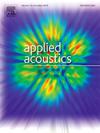The effect of changes in the configuration of a slatted ceiling on reverberation and clarity in a room
IF 3.4
2区 物理与天体物理
Q1 ACOUSTICS
引用次数: 0
Abstract
In architectural design, slat structures such as louvers or panels are extensively employed as finishing systems in both interior and exterior applications. Recently, their use in spaces where acoustics are important has significantly increased, broadening their functional scope. However, notable research gaps exist in evaluating the effects of slat structures on room acoustics, highlighting the need for fundamental data to support their multifunctional applications. This study investigated the effects of horizontally installed slat structures across the entire ceiling area of rooms using scale-model experiments. A 1/15 scale rectangular room was utilized, examining design variables such as the presence of slat structures, upper volume, installation height, slat width, distance, and angle. The effects on reverberation (T30 and EDT) and clarity (C50 and C80) in the room below the slats were systematically measured and analyzed. Generally, installing slat structures shortens the room’s reverberation and increases clarity compared to conditions without slats. By increasing the upper volume, lowering the installation height of the slat structures, and using wider slat width and distance, significant differences in reverberation and clarity can be achieved. In addition, the slat angle should be oriented in a clockwise or counterclockwise direction rather than at 0° to enhance reverberation, clarity, and spatial distribution.
板条天花板结构的变化对室内混响和清晰度的影响
在建筑设计中,诸如百叶或面板之类的板条结构被广泛用作室内和室外的装饰系统。最近,它们在声学重要的空间中的使用显著增加,扩大了它们的功能范围。然而,在评估板条结构对室内声学的影响方面存在着显著的研究空白,这突出了对基础数据的需求,以支持其多功能应用。本研究利用比例模型实验研究了横向安装板条结构对整个房间天花板区域的影响。利用1/15比例的矩形房间,检查设计变量,如板条结构的存在、上部体积、安装高度、板条宽度、距离和角度。系统地测量和分析了对板条下房间混响(T30和EDT)和清晰度(C50和C80)的影响。一般来说,与没有板条的情况相比,安装板条结构可以缩短房间的混响并提高清晰度。通过增加上部容积,降低板条结构的安装高度,使用更宽的板条宽度和间距,可以实现混响和清晰度的显著差异。此外,为了增强混响、清晰度和空间分布,隔板的角度应顺时针或逆时针方向,而不是0°。
本文章由计算机程序翻译,如有差异,请以英文原文为准。
求助全文
约1分钟内获得全文
求助全文
来源期刊

Applied Acoustics
物理-声学
CiteScore
7.40
自引率
11.80%
发文量
618
审稿时长
7.5 months
期刊介绍:
Since its launch in 1968, Applied Acoustics has been publishing high quality research papers providing state-of-the-art coverage of research findings for engineers and scientists involved in applications of acoustics in the widest sense.
Applied Acoustics looks not only at recent developments in the understanding of acoustics but also at ways of exploiting that understanding. The Journal aims to encourage the exchange of practical experience through publication and in so doing creates a fund of technological information that can be used for solving related problems. The presentation of information in graphical or tabular form is especially encouraged. If a report of a mathematical development is a necessary part of a paper it is important to ensure that it is there only as an integral part of a practical solution to a problem and is supported by data. Applied Acoustics encourages the exchange of practical experience in the following ways: • Complete Papers • Short Technical Notes • Review Articles; and thereby provides a wealth of technological information that can be used to solve related problems.
Manuscripts that address all fields of applications of acoustics ranging from medicine and NDT to the environment and buildings are welcome.
 求助内容:
求助内容: 应助结果提醒方式:
应助结果提醒方式:


